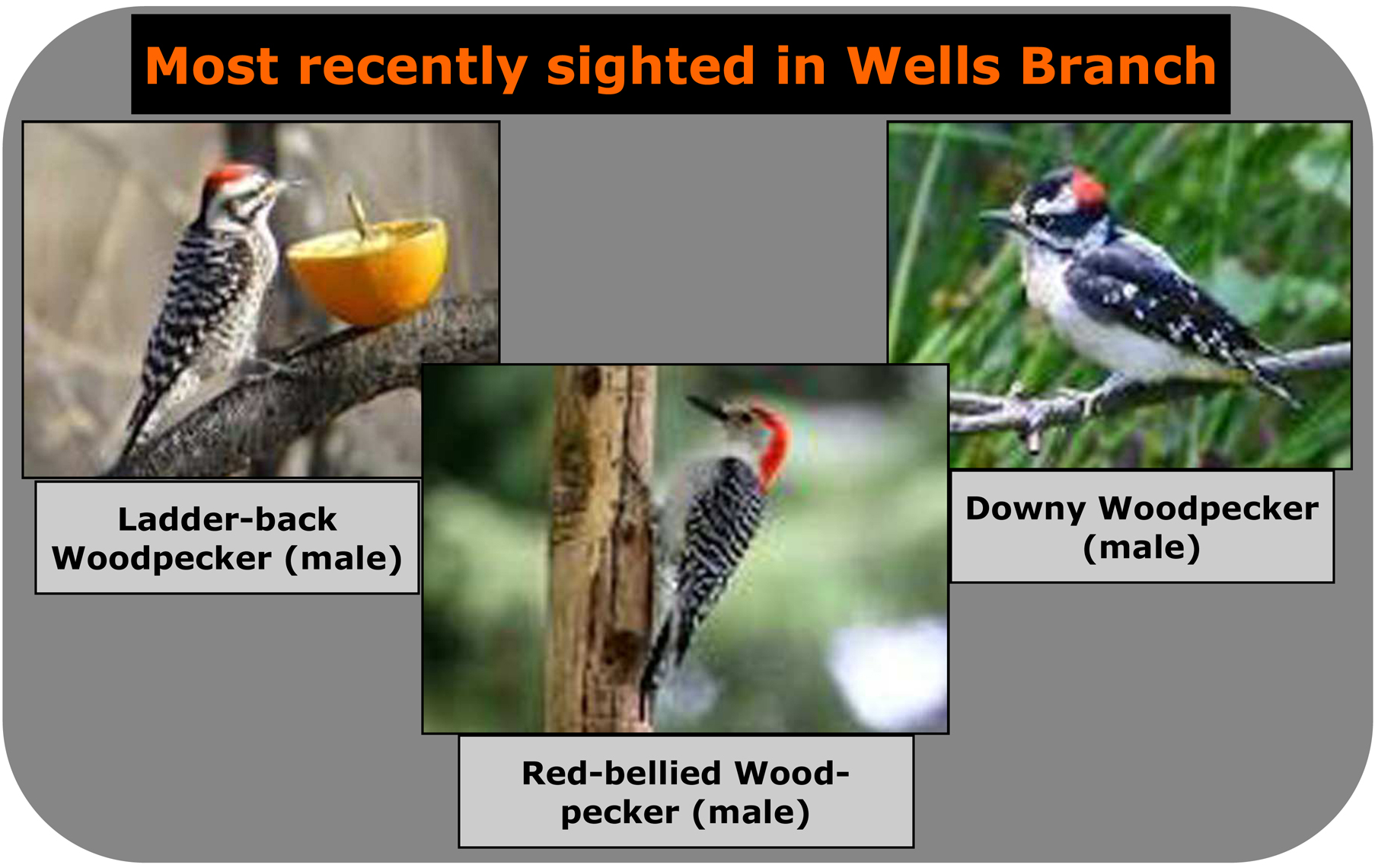 The Top 20 birds of Wells Branch
The Top 20 birds of Wells Branch
by Sharon Richardson and Wanda Holcombe
Did you know that there are at least 20 birds that you can see in Wells Branch any time of the year? The first step of being a better birder is to be able to quickly identify the top 20 (both male and female) by their appearance and by their songs. By being able to make a quick ID of the “usual suspects” you can have an easier time identifying a new bird that may come along. Some birds will be common at the pond while others will be seen in trees around Katherine Fleischer park or in your back yard. The following is a list of the top 20 along with a link to the Cornell Lab of Ornithology All about Birds online bird ID page detailing appearance and songs.
1. White-winged Dove
This is hands-down the most numerous bird in WB. It is a large dove that always shows a white edge on its wings while perched, and will flash a large crescent-shaped white wing patch when flying. They are almost always in groups.
http://www.allaboutbirds.org/guide/White-winged_Dove/id
2. Mourning Dove
In contrast to the White-winged Dove, the Mourning Dove has a trim body with a long tapered tail. It will have heavy spots on its wings. I often see them on telephone wires and around the pond.
http://www.allaboutbirds.org/guide/Mourning_Dove/id
3. House Sparrow
This is the ever-present aggressive bird that will always be at any bird feeder as well as nesting in restaurant signs and in the eaves of your house. I gave up having a Purple Martin house because the House Sparrows drove the Martins away. This bird is introduced and is not related to the North American sparrows. Note that the female is considerably more bland than the male.
http://www.allaboutbirds.org/guide/House_Sparrow/id
4. House Finch
This small songbird is in the category of “LBJ’s” or little brown jobs. The female is indistinct with brown streaked underparts. The male looks like it’s head was dunked in red wine. The head and rump of the male will vary from reddish to orange to almost golden. In the spring time, the male House Finch has a very sweet song. These are common birds at backyard feeders.
http://www.allaboutbirds.org/guide/House_Finch/id
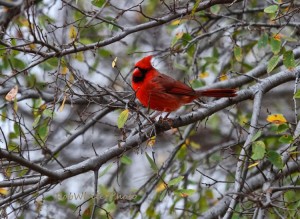
5. Northern Cardinal
The bright overall red male Northern Cardinal is conspicuous and easily recognizable. The female is buffy-brown with a bright red beak. At times, juveniles may have a dark bill. Both sexes sing, which is unusual in the birding world. They seem to be the first birds to sing on a spring morning and the last to leave the feeders in the evening.
http://www.allaboutbirds.org/guide/Northern_Cardinal/id
6. Blue Jay
Both male and female Blue Jays sport the bold blue body, distinct crest, and white wing patches. It is not shy about letting its presence be known. The most common call is a “jay jay jay” but it also mimics the Red-shouldered hawk. They love to take full-out splash baths in my bird bath.
http://www.allaboutbirds.org/guide/Blue_Jay/id
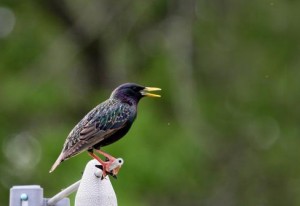
7. European Starling
This is an introduced species that is widespread and aggressive. They have harsh calls and are usually in large groups. A close-up look reveals glossy iridescence with heavy speckling on the wings and breast, but from a distance appears all dark.
http://www.allaboutbirds.org/guide/European_Starling/id
8. Northern Mockingbird
Our state bird is a handsome bird that flashes white wing patches when flying about. It has a varied repertoire of calls both original and imitative. They sit on the tops of trees and just go for it. They even sing all night long in the spring and summer.
http://www.allaboutbirds.org/guide/Northern_Mockingbird/id
9. Great-tailed Grackle
The female is brownish and a bit dull, but the male in springtime is impressive with its glossy purple head, long rudder-like tail and noisy calls. I was startled by how loud these bird can get when I was new to Austin and was going to UT. Watch out below!
http://www.allaboutbirds.org/guide/Great-tailed_Grackle/id
10. Carolina Wren
This small and perky bird has a bold white stripe above its eye with a brown back and buffy underparts. They often hold their tail upright and sing all year long. The male will often sing a “tea-kettle tea-kettle” sound while the female answers with a loud “brrr”.
http://www.allaboutbirds.org/guide/Carolina_Wren/id
11. Carolina Chickadee
A tiny and aptly named bird that says its name- “chick-a-dee-dee-dee” as well as “fee-bee, fee-bay”. I usually see them in pairs. Such cuties.
http://www.allaboutbirds.org/guide/Carolina_Chickadee/id
12. Lesser Goldfinch
This is a small yellow and black bird that has wide variations in plumage’s between adult males, juveniles and females. They eat small thistle seeds as well as other seeds in feeders. If they are not at a feeder for a long time, look for them in fields of sunflowers or ragweed.
http://www.allaboutbirds.org/guide/Lesser_Goldfinch/sounds
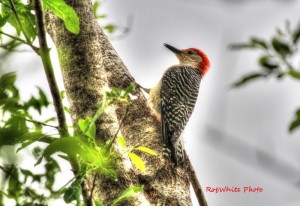
13. Red-bellied Woodpecker
If you see a woodpecker with a black and white striped back and a bit of red on its head, you may likely be encountering a Red-bellied Woodpecker. They are common around the large trees and snags around the pond. The red on their bellies is seldom seen! They have a distinct call and are heard more than they are seen.
http://www.allaboutbirds.org/guide/Red-bellied_Woodpecker/id
14. Red-shouldered Hawk
The Red-tailed Hawk is the most common Hawk in N. America, but the Red-shouldered Hawk is the most common in WB. They can be seen in trees near clearings and around the pond.
http://www.allaboutbirds.org/guide/Red-shouldered_Hawk/id
15. Turkey Vulture
This is a common soaring bird that has a great sense of smell. They are slightly more common than Black Vultures in our area and have pale gray wing edges contrasting with black shoulders. They hold their wings as they soar in a “V” whereas Black Vultures flap more.
http://www.allaboutbirds.org/guide/Turkey_Vulture/id
16. Common Grackle
The juvenile Common Grackle is sooty brown overall in contrast to the adult male that has bluish head, a brown body and a yellow eye. Just not as impressive as the Great-tailed grackles.
http://www.allaboutbirds.org/guide/Common_Grackle/id
17. Great Blue Heron
This is a large gray and blue Heron that is seen most commonly stalking small fish in the pond. They are still for long lengths of time then strike suddenly. I see them flying overhead occasionally as they visit other ponds and notice the long legs and throat pouch.
http://www.allaboutbirds.org/guide/Great_Blue_Heron/id
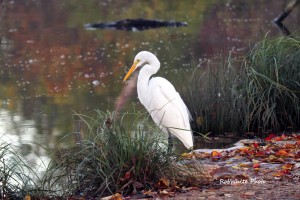
18. Great Egret
This is a large all white Heron with a long yellow bill and black legs. Other white egrets (Snowy or Cattle) are significantly smaller. This bird can be found at the pond enjoying the fishing opportunities.
http://www.allaboutbirds.org/guide/Great_Egret/id
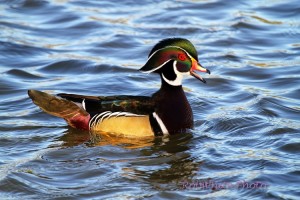
19. Wood Duck
This is a stunningly pretty patterned duck that we have had the great pleasure of hosting on our pond. This is a year-round duck in Central Texas that is a cavity nester but readily takes to Wood Duck houses for successful egg laying.
http://www.allaboutbirds.org/guide/Wood_Duck/id
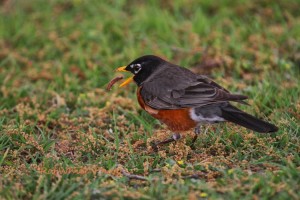
20. American Robin
American Robins can be seen year-round around the WB Homestead. This is actually not a common occurrence in Central Texas. In the winter there are sometimes irruptive occurrences of larger groups of squeaky Robins all over the neighborhood.
http://www.allaboutbirds.org/guide/American_Robin/id